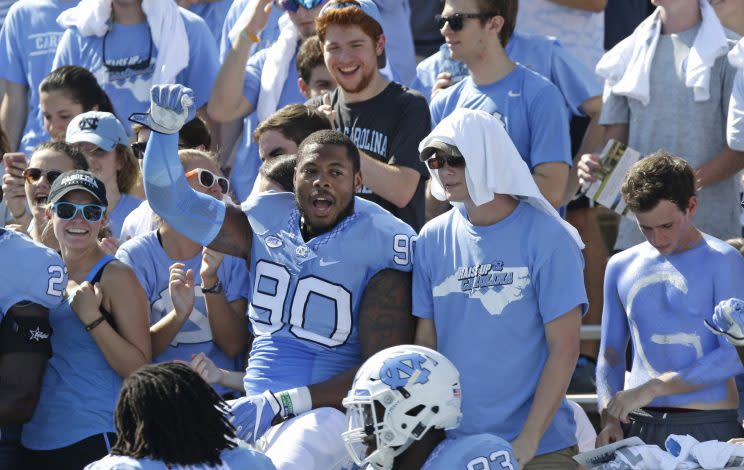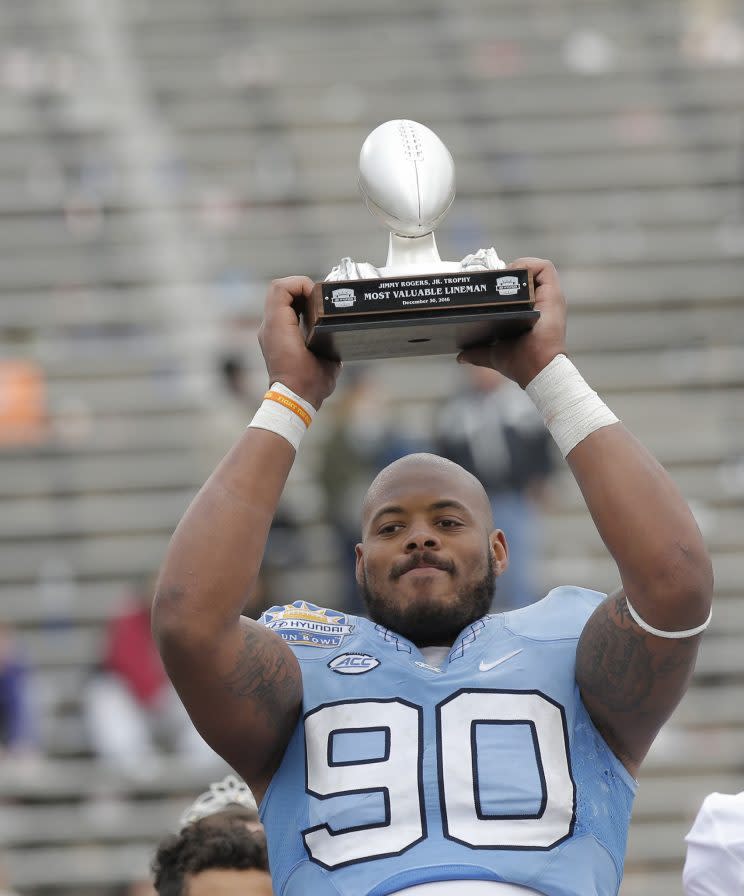NFL draft prospect Nazair Jones on his rare disease: 'On a scale of 1 to 10, the pain was a 12'
CHAPEL HILL, N.C. – He says he has met with just about every NFL team, and every NFL team has asked the same question: What happened to you?
Nazair Jones explains, as best he can, and the reaction is usually the same: “Confusion.”
What Jones faced at age 16 left everyone in his life with confusion. And fear.
“I’m thinking some terrible disease,” says his high school coach, Russell Weinstein, who is now retired. “Is it leukemia?”
Jones was one of those defensive tackles the coaches and scouts drool over, 6-foot-4 and 250 pounds with a size-17 shoe – in high school. He dominated the last game of his junior season at Roanoke Rapids (N.C.) High and had nothing but good things ahead. Then, the morning after that game, he couldn’t walk.
He hadn’t been injured, and yet he was frozen in place – unable to move his legs without agony.
“On a scale of 1 to 10,” Jones says now, “the pain was a 12.”

He could not move, stuck in a frozen stance of agony in his own home. He yelled upstairs to his mom, who thought he was goofing off. Then she came downstairs and saw him standing like some sort of scared statue. The ambulance came soon after and the pain got worse as the paramedics tried to get the giant 16-year-old onto a stretcher.
“I was kind of in shock,” Jones says. “I didn’t know what was going on or what was happening.”
Nobody did. There was no diagnosis for weeks. Weinstein watched with concern as his player would come to school with a limp, or with crutches, or a wheelchair. Weinstein guesses Jones lost 25 pounds in a month, and it got worse from there. Worries about his senior season gave way to worries about his life.
It became so dire that Jones was sent to a research hospital at the University of North Carolina. The first trip didn’t provide answers, but a follow-up finally did.
“Complex Regional Pain Syndrome,” Weinstein remembers. “I had never heard of it.”
According to the National Institute of Health, CRPS is “caused by damage to, or malfunction of, the peripheral and central nervous systems.” It can consist of severe pain in extremities and joints, and the pain can shift from one part of the body to another. It usually affects females and the average age of diagnosis is 40. It was still unknown how this happened to a high school football player. But at that point the doctors only wanted Jones to walk again.
“It can be quite debilitating,” says David Maine, director at the center for interventional pain medicine at Mercy Medical Center in Baltimore. “It’s not really clear why some people develop this. It’s an abnormal response to the nervous system. The most important thing is the diagnosis. It’s not easy. This is not something you can diagnose in a week. It takes time.”
(Jones was treated by Dr. Beth Jonas at the UNC School of Medicine, but because of privacy concerns, she could not grant an interview.)
There is no known cure for CRPS, but once it was diagnosed in Jones, there was finally a way to treat him. He took regular injections of Enbrel, the medication touted by golfer Phil Mickelson for his pain and joint issues. Jones also entered the Ronald McDonald House in Chapel Hill, which is where, as a star football player, he had to learn to walk again.
“A lot of schools completely backed off,” Weinstein says. “The offers did not come. And you can understand it. You can’t offer not knowing if he’d play another down.”
Weinstein admits Jones appeared “like a shell of himself.”
Emotionally, though, Jones didn’t weaken. Even going to the restroom could be excruciating, but that was part of the recovery he always assumed he could achieve.
“Don’t think about the pain,” Jones told himself. “Think about the bigger picture. The pain is something that’s in your way until you are where you want to be.”
In July before his senior year, Jones and his coach went up to UNC to take part in a Tar Heels camp. Weinstein figured it was his player’s last chance to impress coach Larry Fedora and get a scholarship offer.
“I watched Naz go through drills, and I could tell he wasn’t himself,” Weinstein recalls. “As it got warmer, he got dehydrated. He had to go into the training room. I’m telling myself, this thing is over with, it’s just not going to happen.”
Fedora waved the coach over and Weinstein prepared himself for bad news. He recalled the conversation went like this:
“Coach, I’m gonna be honest,” Fedora began. “Based on what I saw today, Naz is not a D-I football player.”
“I understand,” Weinstein said. “It’s been a long journey for him.”
Fedora went on: “But I’ve talked with his doctor, and the prognosis is pretty good. I just can’t get over that junior [game] tape. I’m gonna take a leap of faith.”
Weinstein says now, “I wanted to hug the man and cry.”

Fedora offered Jones a scholarship, provided that he take a redshirt season. Later that day, Jones accepted the offer.
Jones starred at UNC. He missed games with concussion issues, but by his final season he had 70 tackles (9.5 of them for loss) and 2.5 sacks.
He spent a good deal of his extra time volunteering at the Ronald McDonald House where he re-learned to walk. He even brought his teammates along.
“It means everything,” Jones says. “That’s where I did all my therapy. Went through the hardest part of my life in that house.”
Only a short distance from that house, Jones worked out for dozens of NFL scouts at North Carolina’s pro day last month. He says he has heard anywhere from late-first round to the fifth round for his draft position, but the triumph is already his. He is now 6-5, 304 pounds, and six years removed from the fear and confusion of that time in his life. Jones can safely assume he’s the only man in North Carolina who is written up both on NFL.com and on the Rare Disease Report. And he’s happy to talk about it with scouts, general mangers or coaches.
“They are making a million-dollar investment,” he says. “I’ll answer any question they have.”
In the worst of his pain, when he reminded himself about the big picture, Jones was imagining exactly this.
More from Yahoo Sports:
• Russell Westbrook clinches historic triple-double season
• Jeff Passan: Marlins’ mess may scare off potential buyers
• Dan Wetzel: Jury’s question may not bode well for Aaron Hernandez
